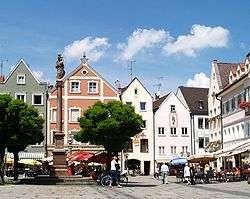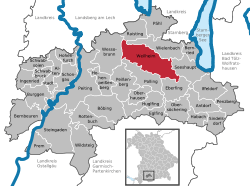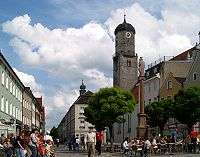Weilheim in Oberbayern
| Weilheim in Oberbayern | ||
|---|---|---|
 Weilheim | ||
| ||
 Weilheim in Oberbayern Location of Weilheim in Oberbayern within Weilheim-Schongau district  | ||
| Coordinates: 47°50′N 11°09′E / 47.833°N 11.150°ECoordinates: 47°50′N 11°09′E / 47.833°N 11.150°E | ||
| Country | Germany | |
| State | Bavaria | |
| Admin. region | Upper Bavaria | |
| District | Weilheim-Schongau | |
| Government | ||
| • Mayor | Markus Loth ("Bürger für Weilheim") | |
| Area | ||
| • Total | 55.44 km2 (21.41 sq mi) | |
| Elevation | 563 m (1,847 ft) | |
| Population (2017-12-31)[1] | ||
| • Total | 22,355 | |
| • Density | 400/km2 (1,000/sq mi) | |
| Time zone | CET/CEST (UTC+1/+2) | |
| Postal codes | 82362 | |
| Dialling codes | 0881 | |
| Vehicle registration | WM | |
| Website | www.weilheim.de | |

Weilheim in Oberbayern (German: Weilheim in Oberbayern) is a town in Germany, the capital of the district Weilheim-Schongau in the south of Bavaria.
Weilheim has an old city-wall, historic houses and a museum.
Local history
Up to the 18th century
The oldest traces of human settlement date back to the Bronze Age[2] and there were grave finds from the Late Roman era.[3] The name Weilheim is interpreted as a home to the Roman villas (land estates). There are, however, several other theories for the roots of the name.[4] Upper Bavaria came in Roman hands through commander Drusus.[5] The Romans built "Via Raetia" in 200 AD, which led over the Brenner Pass to Augsburg.[5][6] This Roman road ran through the Weilheim area.[5] Around 476 AD, the Romans withdrew southwards and the Bavarians came into the region.[7]
The first documentary mention of the village "Wilhain" dates from 16 April 1010 of the king and later Emperor Heinrich II of Bamberg, who granted the monastery of Polling the property of a farm in Weilheim in 1010.[2][8] From about 1080 onwards nobleman of Weilheim appeared, they were vassals from Andechs-Meranier and disappeared around 1312.[2][9] From 1236, there was a palisade fence as a precursor to the town wall.[9][10] Around 1328, the Munich patrician Ludwig Pütrich enabled the establishment of the Heiliggeistspital (lit.: Holy Spirit Hospital) outside the town walls through donations.[2][11] A award of the town is named after him. In the Middle Ages, there were several big fires in Weilheim. When a plague epidemic broke out in Munich in 1521, the Bavarian dukes Wilhelm IV and Ludwig temporarily resided in Weilheim.[2][12] Early in the 17th century, artwork flourished in Weilheim, especially the Weilheimer sculpture school.[13] Well-known representatives from this time were Georg Petel, Hans Krumpper, and Johann Sebastian Degler. In 1611, the so-called Trifthof was set up at the Ammer for log drifting,[2][14] where tree trunks were bond together as rafts to carry them along the waterway down to the Amper.[2][15] In 1639, the Franciscan monastery of St. Joseph was founded at the Schmied Gate because of a lack of priests .[16]
19th and 20th century
The Franciscan monastery in Weilheim was abolished as a result of the secularisation in 1802.[2][17] 120 houses burnt down and two people were killed in a severe fire disaster in the Oberen Stadt (lit.: upper town) on 3 May 1810.[18][19] The former Franciscan monastery burnt down in 1825, after which a Heiliggeistspital was built and a hospital on today's Münchner Straße in 1826.[2][20] On 1 October 1869, the first daily newspaper was published, the "Weilheimer Tagblatt".[2][17] Between 1872 and 1874, three city gates were demolished, the Obere Tor in 1872, the Schmied Gate in 1873, and the Pöltner Gate in 1874.[2][21] 24 people were killed and the train station was destroyed by an air raid in the Second World War on 19 April 1945.[2][22]
Sport
The aeroclub Weilheim-Peißenberg flying at Paterzell airfield is rather successful in glider aerobatics: 2006 German National Champion Markus Feyerabend[23] and Hans-Georg Resch[24] are members of the German national glider aerobatics team.
Transportation
Weilheim has a station on the Munich-Garmisch-Partenkirchen railway.
Famous people

- The Notwist, German indie rock band
- Lali Puna, German EBM band
- Thomas Müller, (born 1989), footballer for Bayern Munich and Germany, was born in the area
- Wilhelm Röntgen (1845-1923), had a mansion in Weilheim and is an honorary citizen
- John Aelbl (born 1552), theologian
- Hans Krumpper (* around 1570–1634) Sculptor, plasterer
- Georg Petel, (died 1635), sculptor who became known as German Michelangelo in the 18th century, was born in 1601 or 1602 in Weilheim
- Franz Hipper, since 1916, Ritter von Hipper (1863–1932) was a German naval officer, last admiral in the Imperial German Navy in First World War.
- Willi Schmid (1893–1934), music critic and poet, as well as victim of confusion of the so-called Night of the long knives (Röhm-Putsch 1934)
- Michael Holm, musician and singer (born 1943 in Szczecin), lives and works in Weilheim
- Markus Acher (born 1967), singer, guitarist and composer
- Max Nagl (born 1987), motocross biker
- Dominik Bittner (born 1995), ice hockey player
International relations
Weilheim in Oberbayern is twinned with:

References
- ↑ "Fortschreibung des Bevölkerungsstandes". Bayerisches Landesamt für Statistik und Datenverarbeitung (in German). September 2018.
- 1 2 3 4 5 6 7 8 9 10 11 12 Bernhard Wöll (Stadtarchiv Weilheim i. OB): Jubiläums-Chronik der Stadt Weilheim, anlässlich der 1000-jährigen erstmaligen urkundlichen Erwähnung im Jahr 1010 von Weilheim und Polling, Herausgeber: Stadt Weilheim i. OB 2010
- ↑ Karl Schmotz: Bemerkungen zur frühen Geschichte Weilheims. In: Lech-Isar-Land 1980, p. 138
- ↑ Bernhard Wöll (Stadtarchiv Weilheim i. OB): Jubiläums-Chronik der Stadt Weilheim, anlässlich der 1000-jährigen erstmaligen urkundlichen Erwähnung im Jahr 1010 von Weilheim und Polling, Herausgeber: Stadt Weilheim i. OB 2010, in der Einleitung
- 1 2 3 Sonderbeilage des Weilheimer Tagblattes anlässlich der 1000-jährigen erstmaligen urkundlichen Erwähnung der Orte Polling und Weilheim vom 16. April 2010, Seite 4
- ↑ Via Raetia, Websitebetreiber: Karl Ludwig Wilhelm, abgerufen am 2. Oktober 2010
- ↑ Geschichte. In: Der Landkreis Weilheim-Schongau. Herausgeber: Landratsamt Weilheim-Schongau 2010, Texte: Max Biller (Kreisarchivpfleger), Helmut Schmidbauer (Kreisheimatpfleger), Seite 8 f
- ↑ Theobald Wirth: Weilheimer Heimatbuch. Geschichte – Kunst und Wissenswertes aus der Stadt an der Ammer. Selbstverlag 1977, p. 18 f, mit deutscher Übersetzung des Textes dieser Urkunde aus dem Lateinischen.
- 1 2 Georg Paula, Stefanie Berg-Hobohm: Landkreis Weilheim-Schongau: Denkmäler in Bayern. Karl M. Lipp, München 2003, Band 2, p. 528
- ↑ Klaus Gast: Die Weilheimer Stadtmauer (Teil 1). In: Lech-Isar-Land 2016, S. 9–24
- ↑ Christian Buck (Hrsg.), Hans Rid: Aus Weilheims Vergangenheit. Entwicklungsgeschichte der Stadt Weilheim vom Mittelalter bis zum Beginn des 20. Jahrhunderts. Stöppel, Weilheim 1984, p. 29
- ↑ Christian Buck (Hrsg.), Hans Rid: Aus Weilheims Vergangenheit. Entwicklungsgeschichte der Stadt Weilheim vom Mittelalter bis zum Beginn des 20. Jahrhunderts. Stöppel, Weilheim 1984, p. 47 f.
- ↑ Vgl. Heinz-Jürgen Sauermost: Die Weilheimer – Große Künstler aus dem Zentrum des Pfaffenwinkels. Süddeutscher Verlag, München 1988
- ↑ Weilheim Chronik: Frühe Neuzeit, retrieved: 29 October 2009
- ↑ Flößerei und Holztrift. In: Georg Paula, Stefanie Berg-Hobohm: Landkreis Weilheim-Schongau: Denkmäler in Bayern. Karl M. Lipp, München 2003, Band 1, Seite XXIII
- ↑ Joachim Heberlein: Weil Priester feh<ten, kamen Mönche. In: Weilheimer Tagblatt, 23./24. Oktober 2010, Seite 3, Lokales
- 1 2 Weilheim Chronik: Jüngere Geschichte, retrieved: 29 October 2009
- ↑ Joachim Heberlein: Feuer vernichtet 120 Häuser. In: Weilheimer Tagblatt, 12./13. Mai 2010, p. 4, Lokales
- ↑ Theobald Wirth: Weilheimer Heimatbuch. Geschichte – Kunst und Wissenswertes aus der Stadt an der Ammer. 2. Auflage. Selbstverlag, 1978, p. 59
- ↑ Christian Buck (Hrsg.), Hans Rid: Aus Weilheims Vergangenheit. Entwicklungsgeschichte der Stadt Weilheim vom Mittelalter bis zum Beginn des 20. Jahrhunderts. Stöppel, Weilheim 1984, p. 133
- ↑ Christian Buck (Hrsg.), Hans Rid: Aus Weilheims Vergangenheit. Entwicklungsgeschichte der Stadt Weilheim vom Mittelalter bis zum Beginn des 20. Jahrhunderts. Stöppel, Weilheim 1984, Seite 211 ff
- ↑ Joachim Heberlein: Weilheims schwarzer Donnerstag kurz vor Kriegsende. In: Weilheimer Tagblatt, 19. April 2010, p. 3, Lokales
- ↑ DAeC: German National Team member Markus Feyerabend (in German) – accessed 2008-02-09
- ↑ DAeC: German National Team member Hans-Georg Resch (in German) – accessed 2008-02-09
| Wikimedia Commons has media related to Weilheim in Oberbayern. |
